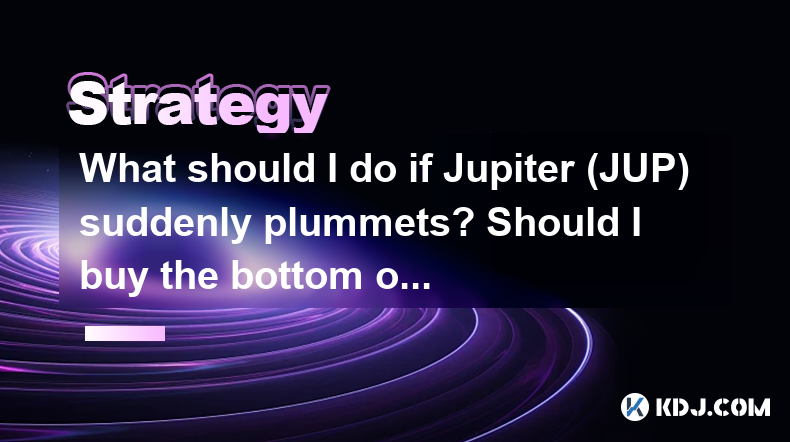-
 bitcoin
bitcoin $124586.364639 USD
0.62% -
 ethereum
ethereum $4670.671710 USD
3.33% -
 xrp
xrp $2.983701 USD
0.18% -
 tether
tether $1.000175 USD
-0.03% -
 bnb
bnb $1209.430642 USD
2.76% -
 solana
solana $231.365861 USD
0.51% -
 usd-coin
usd-coin $0.999665 USD
-0.02% -
 dogecoin
dogecoin $0.264657 USD
4.46% -
 tron
tron $0.346415 USD
1.60% -
 cardano
cardano $0.871586 USD
3.70% -
 chainlink
chainlink $23.451270 USD
7.56% -
 hyperliquid
hyperliquid $46.860071 USD
-2.96% -
 ethena-usde
ethena-usde $1.000120 USD
0.04% -
 sui
sui $3.611279 USD
1.08% -
 stellar
stellar $0.407149 USD
0.96%
What should I do if Jupiter (JUP) suddenly plummets? Should I buy the bottom or stop loss and exit?
If Jupiter (JUP) plummets, consider your strategy: long-term investors might buy the dip, while short-term traders may use stop losses to limit losses.
May 05, 2025 at 02:43 am

If Jupiter (JUP) suddenly plummets, deciding whether to buy the bottom or stop loss and exit can be a challenging decision. This article will explore various strategies and considerations to help you make an informed choice.
Understanding the Plunge
When a cryptocurrency like Jupiter (JUP) experiences a sudden plummet, it's crucial to understand the reasons behind the drop. Factors such as market sentiment, regulatory news, or project-specific issues can all contribute to a price decline. By identifying the root cause, you can better assess whether the drop is temporary or indicative of deeper problems.
Assessing Your Investment Strategy
Before making any decisions, reflect on your overall investment strategy. Are you a long-term investor who believes in the project's fundamentals, or are you a short-term trader looking to capitalize on price movements? Your strategy will significantly influence whether you decide to buy the bottom or exit with a stop loss.
Buying the Bottom: Pros and Cons
Buying the bottom can be an attractive option if you believe the price will rebound. Here are some considerations:
- Potential for High Returns: If the price does recover, buying at the bottom can lead to significant gains.
- Risk of Further Decline: However, if the price continues to fall, you could end up with a larger loss.
To buy the bottom effectively, consider the following steps:
- Monitor Market Trends: Use technical analysis tools to identify potential support levels where the price might stabilize.
- Set a Clear Budget: Determine how much you're willing to invest, and don't exceed this amount.
- Diversify: Avoid putting all your funds into a single asset; diversify your portfolio to mitigate risk.
Stop Loss and Exit: Pros and Cons
Implementing a stop loss and exiting the position can help limit your losses. Here are some key points to consider:
- Loss Prevention: A stop loss can prevent further losses if the price continues to decline.
- Missed Opportunities: However, if the price rebounds quickly, you might miss out on potential gains.
To set up a stop loss effectively, follow these steps:
- Determine Your Stop Loss Level: Decide at what price point you're willing to exit the position. This could be a percentage drop from your entry price or a specific price level.
- Use Trading Platforms: Most cryptocurrency exchanges offer stop loss features. Ensure you're familiar with how to set one up on your chosen platform.
- Regularly Review: Adjust your stop loss levels as needed based on market conditions and your investment strategy.
Emotional Decision-Making
One of the biggest challenges during a price plummet is managing your emotions. Fear and panic can lead to rash decisions. It's essential to stay calm and stick to your predetermined strategy. If you're feeling overwhelmed, take a step back and reassess the situation before making any moves.
Long-Term vs. Short-Term Perspective
Your decision to buy the bottom or use a stop loss may also depend on your investment horizon. Long-term investors might be more inclined to buy the dip, believing in the project's long-term potential despite short-term volatility. Short-term traders, on the other hand, might prefer to use stop losses to protect their capital and move on to other opportunities.
Consulting Market Analysis and News
Staying informed about market analysis and news can provide valuable insights into whether to buy the bottom or exit. Follow reputable sources that cover cryptocurrency trends and news related to Jupiter (JUP). Look for analyses from experts who can provide a broader perspective on the market and the specific factors affecting JUP's price.
Technical Analysis Tools
Technical analysis can be a powerful tool in deciding whether to buy the bottom or use a stop loss. Here are some tools and indicators you might find useful:
- Moving Averages: These can help identify trends and potential reversal points.
- Relative Strength Index (RSI): This can indicate whether an asset is overbought or oversold.
- Support and Resistance Levels: These can help you determine potential buying or selling points.
To use these tools effectively, follow these steps:
- Choose Your Indicators: Select the technical indicators that align with your trading strategy.
- Analyze the Charts: Apply these indicators to JUP's price chart to identify patterns and trends.
- Make Informed Decisions: Use the insights gained from your analysis to decide whether to buy the bottom or set a stop loss.
Risk Management
Regardless of whether you decide to buy the bottom or use a stop loss, effective risk management is crucial. Consider the following:
- Position Sizing: Determine what percentage of your portfolio you're willing to risk on JUP.
- Diversification: Spread your investments across different assets to reduce the impact of a single asset's decline.
- Regular Review: Continuously monitor your positions and adjust your strategy as needed.
FAQs
Q: Can I set multiple stop losses for Jupiter (JUP)?A: Yes, some trading platforms allow you to set multiple stop losses at different price levels. This can be useful if you want to exit a portion of your position at different price points.
Q: How do I know if the price drop is temporary or permanent?A: Distinguishing between a temporary and permanent price drop can be challenging. Look for factors such as market sentiment, project developments, and broader economic conditions. Temporary drops are often driven by short-term market fluctuations, while permanent drops may be linked to fundamental issues with the project.
Q: Should I consult with a financial advisor before making decisions about Jupiter (JUP)?A: If you're unsure about your investment decisions, consulting with a financial advisor can provide personalized guidance. They can help you assess your risk tolerance and align your strategy with your financial goals.
Q: How often should I review my investment in Jupiter (JUP)?A: Regular review is essential for effective investment management. Consider reviewing your JUP position at least weekly, or more frequently if the market is particularly volatile. Adjust your strategy based on new information and market conditions.
Disclaimer:info@kdj.com
The information provided is not trading advice. kdj.com does not assume any responsibility for any investments made based on the information provided in this article. Cryptocurrencies are highly volatile and it is highly recommended that you invest with caution after thorough research!
If you believe that the content used on this website infringes your copyright, please contact us immediately (info@kdj.com) and we will delete it promptly.
- BlockDAG, DOGE, HYPE Sponsorship: Crypto Trends Shaping 2025
- 2025-10-01 00:25:13
- Deutsche Börse and Circle: A StableCoin Adoption Powerhouse in Europe
- 2025-10-01 00:25:13
- BlockDAG's Presale Buzz: Is It the Crypto to Watch in October 2025?
- 2025-10-01 00:30:13
- Bitcoin, Crypto, and IQ: When Genius Meets Digital Gold?
- 2025-10-01 00:30:13
- Stablecoins, American Innovation, and Wallet Tokens: The Next Frontier
- 2025-10-01 00:35:12
- NBU, Coins, and Crypto in Ukraine: A New Yorker's Take
- 2025-10-01 00:45:14
Related knowledge

Practical parameter settings for a Bitcoin multi-timeframe moving average system
Sep 18,2025 at 10:54pm
Optimizing Timeframe Combinations for Bitcoin Trading1. Selecting appropriate timeframes is crucial when building a multi-timeframe moving average sys...

How can I filter out false breakouts in Dogecoin high-frequency trading?
Sep 22,2025 at 01:00am
Understanding False Breakouts in Dogecoin Trading1. A false breakout occurs when Dogecoin's price appears to move beyond a defined support or resistan...

Techniques for identifying tops and bottoms in the Bitcoin on-chain NVT model
Sep 20,2025 at 07:54pm
Understanding the NVT Model in Bitcoin Analysis1. The Network Value to Transactions (NVT) ratio is often described as the 'P/E ratio' of the cryptocur...

What does the surge in open interest in Bitcoincoin futures mean?
Sep 20,2025 at 11:18pm
Understanding the Surge in Dogecoin Futures Open Interest1. A surge in open interest within Dogecoin futures indicates a growing number of active cont...

How can I use the Ethereum USDT premium to gauge market sentiment?
Sep 18,2025 at 11:55pm
Understanding the Ethereum USDT Premium1. The Ethereum USDT premium refers to the price difference between USDT (Tether) traded on Ethereum-based plat...

What should I do if Ethereum staking yields decline?
Sep 20,2025 at 06:18am
Understanding the Causes Behind Declining Ethereum Staking Yields1. The Ethereum network transitioned to a proof-of-stake consensus mechanism with the...

Practical parameter settings for a Bitcoin multi-timeframe moving average system
Sep 18,2025 at 10:54pm
Optimizing Timeframe Combinations for Bitcoin Trading1. Selecting appropriate timeframes is crucial when building a multi-timeframe moving average sys...

How can I filter out false breakouts in Dogecoin high-frequency trading?
Sep 22,2025 at 01:00am
Understanding False Breakouts in Dogecoin Trading1. A false breakout occurs when Dogecoin's price appears to move beyond a defined support or resistan...

Techniques for identifying tops and bottoms in the Bitcoin on-chain NVT model
Sep 20,2025 at 07:54pm
Understanding the NVT Model in Bitcoin Analysis1. The Network Value to Transactions (NVT) ratio is often described as the 'P/E ratio' of the cryptocur...

What does the surge in open interest in Bitcoincoin futures mean?
Sep 20,2025 at 11:18pm
Understanding the Surge in Dogecoin Futures Open Interest1. A surge in open interest within Dogecoin futures indicates a growing number of active cont...

How can I use the Ethereum USDT premium to gauge market sentiment?
Sep 18,2025 at 11:55pm
Understanding the Ethereum USDT Premium1. The Ethereum USDT premium refers to the price difference between USDT (Tether) traded on Ethereum-based plat...

What should I do if Ethereum staking yields decline?
Sep 20,2025 at 06:18am
Understanding the Causes Behind Declining Ethereum Staking Yields1. The Ethereum network transitioned to a proof-of-stake consensus mechanism with the...
See all articles










































































